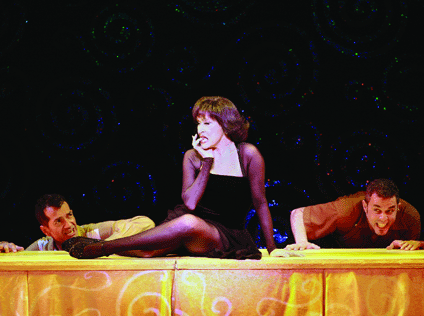Living legend Chita Rivera reprises the old razzle-dazzle
Back in 1993, when Broadway veteran Chita Rivera was slated to star as Aurora in “Kiss of the Spider Woman,” some feared she was too old for such a vigorous role. After all, she’d been hoofing the boards for nearly 40 years. But, boy, did she prove them wrong. The dynamo won a Tony Award for her electrifying performance.
A decade later, in the revival of “Nine,” Rivera defied nay-sayers again with a brief, spectacular turn that earned her an eighth Tony nomination. Even die-hard fans assumed it was her swan song.
And now, against all odds, she’s back on Broadway with her own show, “Chita Rivera: The Dancer’s Life,” a full-throttle celebration of her half-century career. For over two hours, she sashays and shimmies with all the gusto of a woman half her age. She’s 72.
Oh, and did I mention she has 16 metal pins in her leg? They’re a memento of a 1986 car crash, after which doctors insisted she would never dance again.
Without question, the living legend still has plenty of kick left in her.
The pleasantly spirited bio-musical intersperses old classics with mostly forgettable new songs by Lynn Ahrens and Stephen Flaherty (“Ragtime”). Terrence McNally, who collaborated with the star in “The Rink,” “Kiss of Spider Woman,” and “The Visit,” wrote the serviceable book. The show is directed by Graciela Daniele, a former fellow “Chicago” cast member.
Dedicated to “all dancers past, present, and future,” the production features 11 other lively dancers, including Liana Ortiz, who plays Rivera when she took ballet lessons as a young girl. Given that the Latina “triple-threat” thrives in the company of others, the idea of a one-woman show just wasn’t an option.
The show is built around a solid premise: Rivera reflecting upon her life and loves on the magical night she receives the Kennedy Center Honors. In 2002, she was the first Hispanic woman to receive the award. One of her idols, Liz Taylor, was honored that same night.
Oddly enough, an early number, “Secret o’ Life,” a wistful James Taylor song about “enjoying the passage of time” that reflects her philosophy, has no connection to her body of work. Perhaps a better choice might have been, “A Lot of Living to Do,” from her 1960 hit teen musical, “Bye Bye Birdie.”
We learn about Rivera’s childhood in Washington, D.C., where her “familia loca” would urge her to dance on the kitchen table. Born Dolores Conchita Figueroa del Rivero, she wisely truncated her name because “it was too long for the marquee.”
At age 16, she went to New York to study at George Balanchine’s School of American Ballet, and a couple of years later, landed her first gig, “Call Me Madam,” starring Elaine Stritch.
“I was terrified of her,” admits Rivera. After a pause, she dryly adds, “I still am!”
Showing us just why she is a legend, Rivera flits and glides over her vast resume, reprising knockout roles in blockbusters such as “Can-Can,” “Guys & Dolls,” “Sweet Charity,” “Chicago,” and, what many still consider her most illustrious, “West Side Story.” But more often than not, the songs, already abstracted from the glittering context of their shows, are cut to unsatisfying snippets. When she abruptly halts her throaty, pained rendition of “A Boy Like That” after just a few heart-stirring phrases, you can sense a palpable, collective regret from the audience. The finale, “All That Jazz,” is the only number that comes close to recapturing the thrall of past glories—she was the original Velma in “Chicago.”
Rivera croons about her beloved co-stars, such as Gwen Verdon, Dick Van Dyke, Liza Minnelli, and Antonio Banderas. There’s also a didactic number paying homage to the great choreographers, showcasing the nimble muscularity of Jerome Robbins, the Latino heat of Peter Gennaro—who invented all the Sharks’ moves in “West Side Story” and never got a lick of credit—and the graceful restraint of Bob Fosse.
While the dancer’s dancer may lack the flying splits and high kicks of yesteryear, she more than compensates with, as McNally puts it, “infallible technique and generosity of spirit.”
Once in a while, Rivera plops down on a chair to recount a story, and—who could blame her?—catch her breath. Occasionally, she offers up snatches of world-wise wisdom: “If you’re unlucky, you take yourself too seriously and turn into a bitch.”
But if you’re expecting a dishy confessional, a la Elaine Stritch’s “At Liberty,” you’ll be disappointed. Aside from tossing us a few tidbits—her affair with Sammy Davis Jr., regrets about her insanely jealous husband—the show is firmly rooted in the art and craft of being a dancer.
But “The Dancer’s Life” is more than a dance lesson or a mambo down memory lane. It’s a meditation on discipline, trust, and passion. It’s about longevity, and holding fast to the glory that once was theater. Sure, it’s a love-fest, but it’s well-deserved.
With such a legacy, it might be tempting to call her a diva, but please don’t, as the term connotes a selfishness that’s alien to Rivera. Bebe Neuwirth once anointed her “The Goddess of American Theater.” No one who’s seen “The Dancer’s Life” would dare to argue.
gaycitynews.com



































